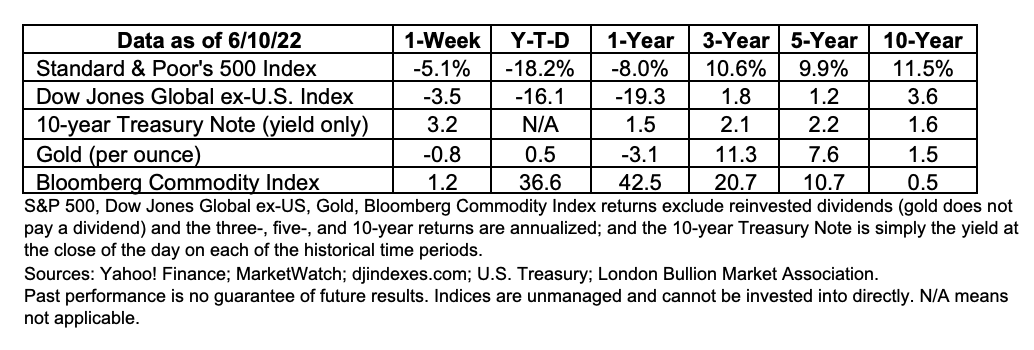Weekly Market Commentary | June 13, 2022
Inflation is proving to be far more tenacious than markets had hoped.
The idea that inflation peaked in March was put to rest last week when the Consumer Price Index (CPI) showed that inflation accelerated in May. Overall, prices were up 8.6 percent last month, an increase from April’s 8.3 percent. It was the highest inflation reading we’ve seen since December 1981.
The most significant price increases were in energy (+34.6%) and food (+10.1%). That’s unfortunate because the War in Ukraine has a significant influence on food and energy prices right now, and no one knows how long it will last. In April, the World Bank’s Commodity Markets Outlook reported:
“The war in Ukraine has been a major shock to global commodity markets. The supply of several commodities has been disrupted, leading to sharply higher prices, particularly for energy [natural gas, coal, crude oil], fertilizers, and some grains [wheat, barley, and corn].”
With inflation rising, the Federal Reserve will continue to aggressively raise the federal funds rate. There is a 50-50 chance the Fed will raise rates by 0.75 percent in July (rather than 0.50 percent), and some economists say there could be a 0.75% hike this week when the Fed meets, reported Scott Lanman and Kristin Aquino of Bloomberg.
The inflation news unsettled already volatile stock and bond markets. Major U.S. stock indices declined last week as investors reassessed the potential impact of higher interest rates and inflation on company earnings and share prices, reported Randall W. Forsyth of Barron’s. The Treasury yield curve flattened a bit as the yield on two-year Treasuries rose to a multi-year high, reported Jacob Sonenshine and Jack Denton of Barron’s. The benchmark 10-year Treasury Note finished the week yielding more than 3 percent.
There was a hint of good news in the report. The core CPI, which excludes food and energy prices because they are volatile and can distort pricing trends, is trending lower. It dropped from 6.5 percent in March to 6.2 percent in April and 6.0 percent in May.
The Federal Reserve’s favored inflation gauge is the Personal Consumption Price (PCE) Index, which will be released on June 30.

COPING WITH A BEAR MARKET IS NOT EASY. A bear market occurs when stocks have declined in value by about 20 percent or more. Investing during a bear market can be a lot like playing baseball for a team that’s in a slump. Your teammates are worried, hecklers distract the players’ attention, and the team’s record of wins and losses moves in the wrong direction. You might find yourself beginning to question whether playing baseball is right for you.
Before you decide to exit the game, here are some tips for coping with bear markets:
- Remember, downturns don’t last forever. The Standard & poor’s 500 Index has experienced 7 bear markets over the last 50 years and recovered from all of them, reported Thomas Franck of CNBC. Here’s a rundown of the duration and returns of bear and bull markets since 1973.
Year Bear market Total return Bull market Total return
1973 21 months -48 percent 74 months +126 percent
1980 20 months -27 percent 60 months +229 percent
1987 3 months -34 percent 31 months + 65 percent
1990 3 months -20 percent 113 months +417 percent
2000 31 months -49 percent 60 months +102 percent
2007 7 months -57 percent 131 months +401 percent
2020 1 month -27 percent TBD TBD
“Bull markets tend to last far longer and generate moves of far greater magnitude than bear markets. Time after time, bear markets have proven to be good buying opportunities for long-term investors,” explained Franck. Remember, past performance does not guarantee future results.
- Stay diversified. Make sure your portfolio remains well diversified. During bear markets, some segments of the market will outperform while others underperform. A diversified portfolio can provide a cushion. Diversification won’t help you avoid a loss, but it can help minimize it.
- Talk with us. During market downturns, investors often panic. That causes some to sell investments and incur losses that may be difficult to recover. If you’re tempted to sell, give us a call first. We’ll discuss your concerns, review your portfolio and help you decide on a course of action.
Possibly the most important things you can do during a bear market are to stay calm and resist making any sudden moves.
Weekly Focus – Think About It
“You get recessions, you have stock market declines. If you don't understand that's going to happen, then you're not ready, you won't do well in the markets."
—Peter Lynch, former portfolio manager
Please feel free to forward this commentary to family, friends or colleagues. If you would like us to add them to the list, please reply to this email with their email address and we will ask for their permission to be added.
Securities offered through IFP Securities, LLC, dba Independent Financial Partners (IFP), Member FINRA/SIPC. Investment advice offered through IFP Advisors, LLC, dba Independent Financial Partners (IFP), a Registered Investment Advisor. IFP and LIFETIME WEALTH STRATEGIES, LLC are not affiliated.
* These views are those of Carson Coaching, not the presenting Representative, the Representative’s Broker/Dealer, or Registered Investment Advisor, and should not be construed as investment advice.
* This newsletter was prepared by Carson Coaching. Carson Coaching is not affiliated with the named firm or broker/dealer.
* Government bonds and Treasury Bills are guaranteed by the U.S. government as to the timely payment of principal and interest and, if held to maturity, offer a fixed rate of return and fixed principal value. However, the value of fund shares is not guaranteed and will fluctuate.
* Corporate bonds are considered higher risk than government bonds but normally offer a higher yield and are subject to market, interest rate and credit risk as well as additional risks based on the quality of issuer coupon rate, price, yield, maturity, and redemption features.
* The Standard & Poor's 500 (S&P 500) is an unmanaged group of securities considered to be representative of the stock market in general. You cannot invest directly in this index.
* All indexes referenced are unmanaged. The volatility of indexes could be materially different from that of a client’s portfolio. Unmanaged index returns do not reflect fees, expenses, or sales charges. Index performance is not indicative of the performance of any investment. You cannot invest directly in an index.
* The Dow Jones Global ex-U.S. Index covers approximately 95% of the market capitalization of the 45 developed and emerging countries included in the Index.
* The 10-year Treasury Note represents debt owed by the United States Treasury to the public. Since the U.S. Government is seen as a risk-free borrower, investors use the 10-year Treasury Note as a benchmark for the long-term bond market.
* Gold represents the 3:00 p.m. (London time) gold price as reported by the London Bullion Market Association and is expressed in U.S. Dollars per fine troy ounce. The source for gold data is Federal Reserve Bank of St. Louis (FRED), https://fred.stlouisfed.org/series/GOLDPMGBD228NLBM.
* The Bloomberg Commodity Index is designed to be a highly liquid and diversified benchmark for the commodity futures market. The Index is composed of futures contracts on 19 physical commodities and was launched on July 14, 1998.
* The DJ Equity All REIT Total Return Index measures the total return performance of the equity subcategory of the Real Estate Investment Trust (REIT) industry as calculated by Dow Jones.
* The Dow Jones Industrial Average (DJIA), commonly known as “The Dow,” is an index representing 30 stock of companies maintained and reviewed by the editors of The Wall Street Journal.
* The NASDAQ Composite is an unmanaged index of securities traded on the NASDAQ system.
* International investing involves special risks such as currency fluctuation and political instability and may not be suitable for all investors. These risks are often heightened for investments in emerging markets.
* Yahoo! Finance is the source for any reference to the performance of an index between two specific periods.
* The risk of loss in trading commodities and futures can be substantial. You should therefore carefully consider whether such trading is suitable for you in light of your financial condition. The high degree of leverage is often obtainable in commodity trading and can work against you as well as for you. The use of leverage can lead to large losses as well as gains.
* Opinions expressed are subject to change without notice and are not intended as investment advice or to predict future performance.
* Economic forecasts set forth may not develop as predicted and there can be no guarantee that strategies promoted will be successful.
* Past performance does not guarantee future results. Investing involves risk, including loss of principal.
* The foregoing information has been obtained from sources considered to be reliable, but we do not guarantee it is accurate or complete.
* There is no guarantee a diversified portfolio will enhance overall returns or outperform a non-diversified portfolio. Diversification does not protect against market risk.
* Asset allocation does not ensure a profit or protect against a loss.
* Consult your financial professional before making any investment decision
Sources:
https://www.bls.gov/news.release/cpi.nr0.htm
https://www.bls.gov/news.release/archives/cpi_05112022.htm
https://openknowledge.worldbank.org/bitstream/handle/10986/37223/CMO-April-2022.pdf [Page 4]
https://www.bloomberg.com/news/articles/2022-06-10/barclays-sees-75-basis-point-fed-hike-next-week-on-price-surge (or go to https://resources.carsongroup.com/hubfs/WMC-Source/2022/06-13-22_Bloomberg_Barclays%2c%20Traders%20Set%20Sights%20on%20Fed%20Rate%20Hike_4.pdf)
https://www.barrons.com/articles/inflation-is-hot-and-stocks-are-cold-now-the-fed-needs-to-rethink-its-rosy-projections-51654908515 (or go to https://resources.carsongroup.com/hubfs/WMC-Source/2022/06-13-22_Barrons_Inflation%20is%20Hot%20and%20Stocks%20Are%20Cold_5.pdf)
https://www.barrons.com/articles/stock-market-today-51654850113?mod=hpsubnav
https://www.frbsf.org/education/publications/doctor-econ/2004/october/core-inflation-headline/
https://www.bls.gov/news.release/archives/cpi_04122022.htm
https://www.cnbc.com/2020/03/14/a-look-at-bear-and-bull-markets-through-history.html
https://www.investopedia.com/financial-edge/0511/the-top-17-investing-quotes-of-all-time.aspx
The information given herein is taken from sources that IFP Advisors, LLC, dba Independent Financial Partners (IFP), IFP Securities LLC, dba Independent Financial Partners (IFP), and its advisors believe to be reliable, but it is not guaranteed by us as to accuracy or completeness. This is for informational purposes only and in no event should be construed as an offer to sell or solicitation of an offer to buy any securities or products. Please consult your tax and/or legal advisor before implementing any tax and/or legal related strategies mentioned in this publication as IFP does not provide tax and/or legal advice. Opinions expressed are subject to change without notice and do not take into account the particular investment objectives, financial situation, or needs of individual investors. This report may not be reproduced, distributed, or published by any person for any purpose without IFP’s express prior written consent.

